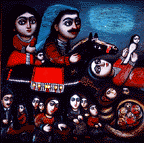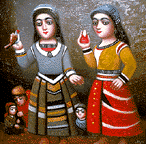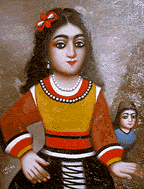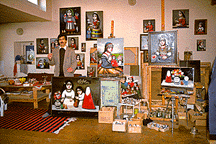|
|
 |
 |
 |
One of the characteristics of my paintings is that I use Arabic. These days I'm using it somewhat more moderately than before. But it does seem to me that the emptiness of the background requires an inscription of "Bismi Allah" ("in the name of Allah"), a phrase taken from the Quran. This is connected with my faith in Allah. Each of my works contains the name of Allah. I use Arabic script as it corresponds so well to the genre of painting, far better than Cyrillic. And I always sign my paintings "Gaiyur" in Arabic. Of course, Arabic has a historical base as it was Azerbaijan's official alphabet until the late 1920s. And it is the script of our famous poets in the past, Fizuli and Nizami.
Art Today
Today, it is possible for us to work freely and to present our paintings openly at exhibitions. But we need more than that, especially during these critical economical times when our country is under such pressure with the war and refugees. People have to help art develop. But nobody really helps. There are many political parties, many banks, and many associations. Most of them include special by-laws and articles about art. But, in truth, these organizations aren't actively supporting the arts and artists.

Left: Gaiyur Yunus in
his studio in Amirjan, a suburb of Baku. December 1994. Canvases
are lighter, brighter and smaller these days.
What we need is a window to the world. We must be presented to
the world. We must become known to a larger international audience.
There are many talented artists in Azerbaijan and, at least,
ten to fifteen of them should be made known to the world.
Gaiyur Yunus, born in Baku in 1948, is often associated
by his stylized portraits and use of smooth lines and brilliant
colors, especially red, white, and turquoise against black backgrounds.
His work, "Refugee", was featured on the back cover
of Azerbaijan International (Winter 1994, Vol. 2:1). His studio
is in the suburb of Amirjan, a suburb of Baku. Telephone (994-12)
203-833.
Translation assistance by Jamila Pashayeva.
From Azerbaijan
International
(3.1)
Spring 1995.
© Azerbaijan International 1995. All rights reserved.

